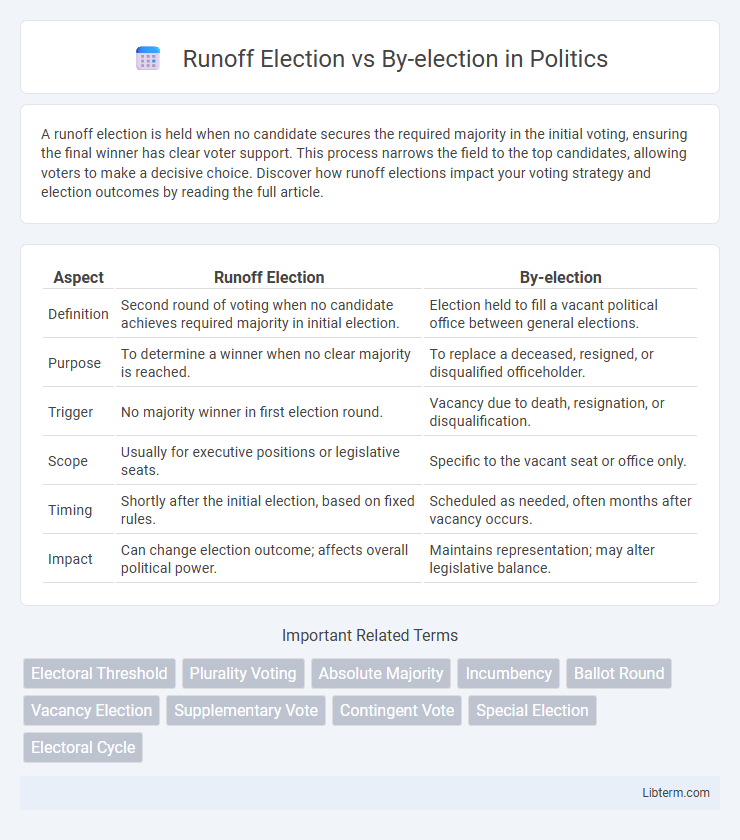A runoff election is held when no candidate secures the required majority in the initial voting, ensuring the final winner has clear voter support. This process narrows the field to the top candidates, allowing voters to make a decisive choice. Discover how runoff elections impact your voting strategy and election outcomes by reading the full article.
Table of Comparison
| Aspect | Runoff Election | By-election |
|---|---|---|
| Definition | Second round of voting when no candidate achieves required majority in initial election. | Election held to fill a vacant political office between general elections. |
| Purpose | To determine a winner when no clear majority is reached. | To replace a deceased, resigned, or disqualified officeholder. |
| Trigger | No majority winner in first election round. | Vacancy due to death, resignation, or disqualification. |
| Scope | Usually for executive positions or legislative seats. | Specific to the vacant seat or office only. |
| Timing | Shortly after the initial election, based on fixed rules. | Scheduled as needed, often months after vacancy occurs. |
| Impact | Can change election outcome; affects overall political power. | Maintains representation; may alter legislative balance. |
Introduction to Runoff Elections and By-elections
Runoff elections occur when no candidate achieves the required majority vote, prompting a second round between the top candidates to ensure a decisive winner. By-elections, also known as special elections, are held to fill political office vacancies arising between general elections due to resignation, death, or disqualification. Both election types serve distinct democratic functions: runoff elections resolve initial electoral indecision, while by-elections maintain uninterrupted representation in legislative bodies.
Definition of Runoff Election
A runoff election is a subsequent voting process held when no candidate achieves the required majority in the initial election, ensuring the winner has broad support by limiting the contest to the top candidates. This electoral system contrasts with a by-election, which occurs to fill a vacant legislative seat between general elections. Runoff elections are commonly used in presidential and local races to guarantee that the elected official reflects the majority preference.
Definition of By-election
A by-election is a special election held to fill a political office that becomes vacant between general elections due to resignation, death, or disqualification of the sitting member. Unlike a runoff election, which occurs when no candidate achieves the required majority in a general election, a by-election addresses an unexpected vacancy in legislative bodies such as parliaments, councils, or assemblies. This election ensures continuous representation of constituents without waiting for the regular election cycle.
Key Differences Between Runoff Elections and By-elections
Runoff elections occur when no candidate achieves the required majority vote in the initial election, necessitating a second round between top candidates, while by-elections fill vacancies that arise between general elections due to resignation, death, or disqualification of an incumbent. Runoff elections are primarily designed to ensure majority support for elected officials, whereas by-elections maintain continuous representation in legislative bodies. The timing of runoff elections follows the general electoral schedule closely, whereas by-elections are held as needed based on specific seat vacancies.
When Is a Runoff Election Held?
A runoff election is held when no candidate achieves the required majority of votes, typically over 50%, during the initial election, necessitating a second round between the top contenders. This ensures the winner has clear voter support, unlike a by-election, which occurs to fill a vacancy outside the regular election cycle due to resignation or death. Runoff elections are common in countries with majority voting systems to guarantee that elected officials reflect the electorate's preference.
Scenarios Triggering a By-election
A by-election is triggered when a legislative seat becomes vacant due to resignation, death, or disqualification of a sitting member, unlike a runoff election which occurs when no candidate achieves the required majority in a general election. Scenarios prompting a by-election include unexpected vacancies in parliamentary seats or local government positions, ensuring representation continuity. By-elections maintain democratic legitimacy by filling seats outside the regular election cycle.
Voting Process in Runoff Elections
Runoff elections require a second round of voting when no candidate achieves the required majority in the initial vote, ensuring the winner has broader support. Voters return to the polls to choose between the top two candidates, making the process more decisive and reducing the risk of a winner lacking majority approval. This system contrasts with by-elections, which fill vacant seats without necessarily involving multiple voting rounds.
How By-elections Are Conducted
By-elections are conducted to fill political vacancies that arise between general elections, often triggered by resignation, death, or disqualification of a sitting member. The electoral process follows standard voting procedures, including voter registration, candidate nomination, campaigning, and ballot casting within the specific constituency affected. Election commissions oversee by-elections to ensure transparency, fairness, and adherence to legal frameworks, with results determining which candidate will serve the remaining term.
Impacts of Runoff Elections vs By-elections on Political Outcomes
Runoff elections often lead to higher political legitimacy by ensuring that elected candidates receive majority support, which can reduce polarization and increase voter confidence in the outcome. By-elections, held to fill vacant seats outside the regular election cycle, can shift political power balances unpredictably due to lower voter turnout and localized issues dominating the vote. The differing voter engagement and timing in runoff elections versus by-elections significantly influence party strategies and overall political stability.
Conclusion: Choosing the Right Electoral Process
Choosing between a runoff election and a by-election depends on the specific electoral context and objectives. Runoff elections ensure majority support by requiring a second round if no candidate achieves a majority initially, promoting legitimacy in tightly contested races. By-elections fill unexpected vacancies between general elections, maintaining representation continuity without altering the broader electoral schedule.
Runoff Election Infographic

 libterm.com
libterm.com